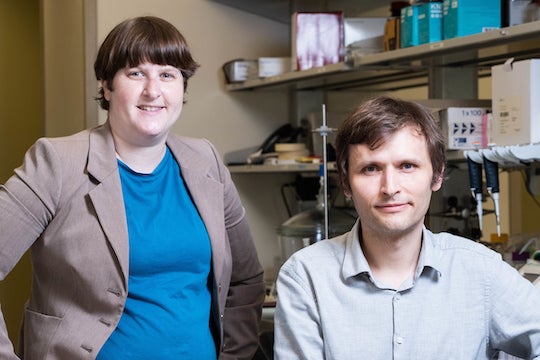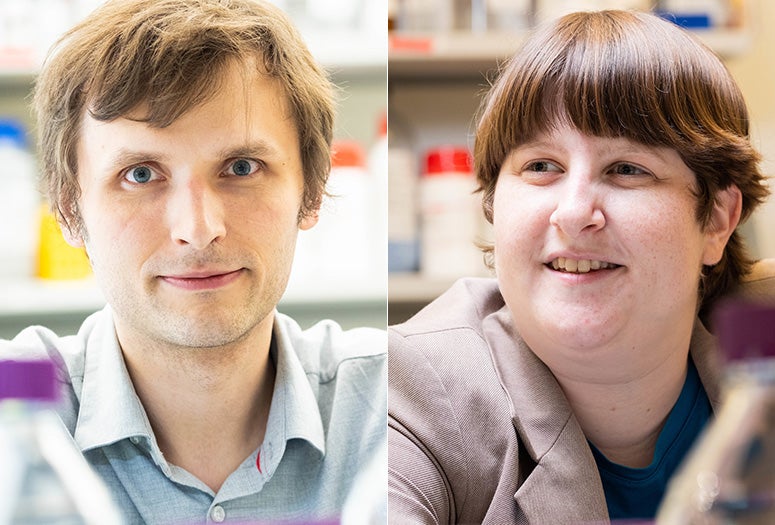Two Rice University bioengineers received the National Institutes of Health (NIH) Director’s New Innovator Award (NIA) for creative research projects demonstrating broad impact potential.

Part of the High-Risk, High-Reward Research program, NIA awards support early-career investigators with ambitious, unconventional project proposals “in any area of biomedical, behavioral or social science research relevant to the NIH mission,” according to the agency’s website.
Rice’s Jerzy Szablowski and Julea Vlassakis will use the grants for their individual projects. Szablowski is developing a noninvasive, high-resolution method of mapping gene expression, and Vlassakis is studying complex, single-cell level processes and interactions in a model of pediatric bone cancer.
It is the first time that Rice researchers received the distinction.
“It’s like lightning struck the same spot twice,” Vlassakis said, noting the highly competitive selection process. Szablowski added that the awards are “pretty unique compared to typical NIH grants,” offering a greater amount of freedom to explore and innovate.
“Science can be quite unpredictable, so this allows us to take greater risks that could lead to transformative outcomes,” he said.
Szablowski’s research project is focused on developing synthetic markers carried in the bloodstream that relay detailed information on how genes get expressed in the brain. Known as “Released Markers of Activity” or RMAs, these reporters can provide information on as few as 100 cells or fewer, making them a high-sensitivity tool applicable to a variety of monitoring purposes.
“Gene expression underlies a lot of different biological processes,” said Szablowski, an assistant professor of bioengineering. “But because this process takes place inside cells, you can’t spy on it unless you go inside the cell and mash it up and analyze its contents. This is not ideal when you’re trying to keep track of something that’s happening deep inside tissue over time.

“The ability to monitor gene expression with a blood test would allow you to track how a single area of tissue changes over time and learn, for example, what makes some people susceptible to developing an addiction or an illness like Parkinson’s.”
RMAs are especially useful for surveilling parts of the body that are difficult or dangerous to sample, like the spinal cord or the brain.
“We have tools to noninvasively deliver genes to tissues,” Szablowski said. “This tool makes it possible to measure the gene expression noninvasively in a way that simply wasn’t possible beforehand.”
The markers can also be used to track neuronal activity to assess the effect of certain medications or to study how the brain processes pain or anxiety. This could potentially allow researchers to more accurately diagnose pain or anxiety disorders and lead to more effective therapies.
“We’re particularly interested in applications of this kind of recording in anxiety-related disorders,” Szablowski said. “RMAs will allow us to measure how the brain responds to different anxiety-inducing environments and to compare these responses.”
The funding enables Szablowski to work on increasing the sensitivity of the synthetic markers to the single-cell level and on diversifying the range of physiological processes they monitor.
Vlassakis will use the grant to study how cancerous cells and immune cells interact, looking to shed light on the mechanisms that allow tumor cells to evade or repel immune defenses. Her work will focus specifically on Ewing sarcoma, the second most common pediatric bone cancer.
“We’ll study the interplay between cells that leave from the tumor and spread elsewhere in the body and the immune system, which should be able to recognize those cells as not normal and shut down the process,” said Vlassakis, an assistant professor of bioengineering and a Cancer Prevention and Research Institute of Texas (CPRIT) Scholar. “But, in fact, immune cells don’t do a very good job of identifying spreading cancer cells.”

Vlassakis seeks to recreate the kinds of intercellular interactions that take place as a tumor is spreading using detailed, three-dimensional models that replicate the tumor microenvironment.
“There really hasn’t been a model for Ewing sarcoma that encompasses the tumor, the immune cells and a material that best mimics bone environment,” Vlassakis said.
Vlassakis is also developing ways to extract individual cells from the models and analyze their make-up and behaviors at the protein level.
“We care about measuring single cells because there’s some variation from cell to cell that can be meaningful in terms of which cells are the ones aggressively invading the environment and driving the cancer to spread versus the less migratory cells,” Vlassakis said. “Ultimately, those cells will have distinct proteins that they’re expressing that are helping them carry out their specific function.”
Understanding individual differences between cells may help uncover ways to interrupt metastatic processes, Vlassakis said. But in order to analyze them, she has to lure the cells into tiny devices designed to measure the proteins they express, their structure and more.
“By sprinkling in some factors that the cells are known to gravitate towards, we’re aiming to get them to migrate into microwells that we design that are part of our single-cell protein-measurement devices,” Vlassakis said. “We’re really interested in integrating single-cell measurement technologies as we probe the biology of cells in these tumor models.”
The technologies Vlassakis is working on could be used to measure and observe other types of cells, laying the groundwork for more fine-grained analyses of various other cancers and disease states such as autoimmune disorders.
“We’re just learning more and more about the importance and really mystifying nature of the immune system,” Vlassakis said. “Getting this award is a great honor, and it’s really exciting to get the resources and time to delve more deeply into this research.”
- Award information:
-
“Monitoring neuronal activity with a blood test - Released Markers of Activity (RMA)” | National Institute of Biomedical Imaging and Bioengineering | Principal Investigator: Jerzy Szablowski | Project number: 1DP2EB035905-01
https://reporter.nih.gov/search/tqAPqmyRFUCr72wLKQRQNw/project-details/10687503“Deep phenotyping of fusion oncoprotein-driven pediatric cancer metastasis with single-cell proteomics” | National Cancer Institute | Principal Investigator: Julea Vlassakis | Project number: 1DP2CA290802-01
https://reporter.nih.gov/search/tqAPqmyRFUCr72wLKQRQNw/project-details/10687394 - Image downloads:
-
https://news-network.rice.edu/news/files/2023/09/230925_NIH_Fitlow_7811.jpg
CAPTION: Julea Vlassakis (left) and Jerzy Szablowski have won the NIH Director’s New Innovator Award. (Photo by Jeff Fitlow/Rice University)
https://news-network.rice.edu/news/files/2023/10/230925_NIH_Fitlow_7802.jpg
CAPTION: Jerzy Szablowski is an assistant professor of bioengineering at Rice University. (Photo by Jeff Fitlow/Rice University)https://news-network.rice.edu/news/files/2023/09/230925_NIH_Fitlow_7794.jpg
CAPTION: Julea Vlassakis is an assistant professor of bioengineering and a Cancer Prevention and Research Institute of Texas (CPRIT) Scholar. (Photo by Jeff Fitlow/Rice University)
- Related stories:
-
DARPA grant will fund hunt for drug that can keep people warm:
https://news.rice.edu/news/2023/darpa-grant-will-fund-hunt-drug-can-keep-people-warm
Rice bioengineer seeks better signals from cells:
https://news.rice.edu/news/2022/rice-bioengineer-seeks-better-signals-cellsSzablowski receives Michael J. Fox grant for Parkinson’s Research:
https://bioengineering.rice.edu/news/szablowski-receives-michael-j-fox-grant-parkinsons-researchBioengineering department adds single-cell expert via CPRIT grant:
https://news.rice.edu/news/2021/bioengineering-department-adds-single-cell-expert-cprit-grant - Links:
-
Department of Bioengineering: https://bioengineering.rice.edu/
Microtechnologies Laboratory for Pediatric Oncology: https://vlassakislab.rice.edu/
Laboratory for Noninvasive Neuroengineering: https://www.szablowskilab.org/
Cancer Prevention and Research Institute of Texas (CPRIT): https://www.cprit.texas.gov/
- About Rice:
-
Located on a 300-acre forested campus in Houston, Rice University is consistently ranked among the nation’s top 20 universities by U.S. News & World Report. Rice has highly respected schools of Architecture, Business, Continuing Studies, Engineering, Humanities, Music, Natural Sciences and Social Sciences and is home to the Baker Institute for Public Policy. With 4,552 undergraduates and 3,998 graduate students, Rice’s undergraduate student-to-faculty ratio is just under 6-to-1. Its residential college system builds close-knit communities and lifelong friendships, just one reason why Rice is ranked No. 1 for lots of race/class interaction and No. 4 for quality of life by the Princeton Review. Rice is also rated as a best value among private universities by Kiplinger’s Personal Finance.

